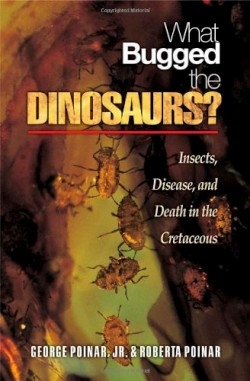What Bugged the Dinosaurs
Insects Disease and Death in the Cretaceous
“If all mankind were to disappear, the world would regenerate back to the rich state of equilibrium that existed ten thousand years ago,” says Edward O. Wilson. “If insects were to vanish, the environment would collapse into chaos.” Others claim that the removal of bees, ants and termites alone would be enough to cause ecological calamity. This astonishing tidbit gives us a good idea of just how vital insects are to virtually all of earth’s terrestrial ecosystems, which, according to George and Roberta Poinar, has probably been the case for most of the 350-400 million years that insects have been evolving.
What Bugged the Dinosaurs tells the story of insects’ tremendous impact on Cretaceous ecosystems, thereby questioning the common assumption that dinosaurs were the uncontested rulers of their domain. In the process of making their point, the Poinars cover a great deal of ground, from the formation of amber fossils in ancient araucarian forests to the emergence of angiosperms and their symbionts, the insect pollinators, from a general overview of Cretaceous ecology to specific studies of mosquitoes and parasitic worms.
There are fascinating chapters on the evolution of pathogens, what makes insects “the ultimate survivors,” and the nature of extinctions—specifically the one marked by the K/T boundary, which killed off the dinosaurs some 65 million years ago. The Poinars are recognized experts on fossil insects, particularly those preserved in amber, from which they have pioneered efforts to extract DNA. They have written a number of books on the subject, including The Amber Forest: A Reconstruction of a Vanished World, Lebanese Amber: The Oldest Insect Ecosystem in Fossilized Resin, and The Quest for Life in Amber. George and his team worked as consultants on the film version of Jurassic Park. He holds a Ph.D. in Biology from Cornell, while Roberta, who studied at Berkeley, is an electron microscopist. Together, they founded the Amber Institute in Oregon.
The scientific and, at times, technical, subject of this book is complemented by an often colorful narrative style. Many chapters begin with scene-setting flourishes like, “It was not long after the predators finished feasting on the corpse of the diseased ornithopod that the first raindrops of an approaching storm began to fall.”
This book is worthwhile for lay readers as well as experts, because it highlights the evolution of ecosystems, and in so doing, shows that planet Earth does not need ostensibly dominant creatures like dinosaurs and Homo sapiens. This is a lesson that we do well to spread far and wide, and to revisit repeatedly.
Disclosure: This article is not an endorsement, but a review. The publisher of this book provided free copies of the book to have their book reviewed by a professional reviewer. No fee was paid by the publisher for this review. Foreword Reviews only recommends books that we love. Foreword Magazine, Inc. is disclosing this in accordance with the Federal Trade Commission’s 16 CFR, Part 255.

